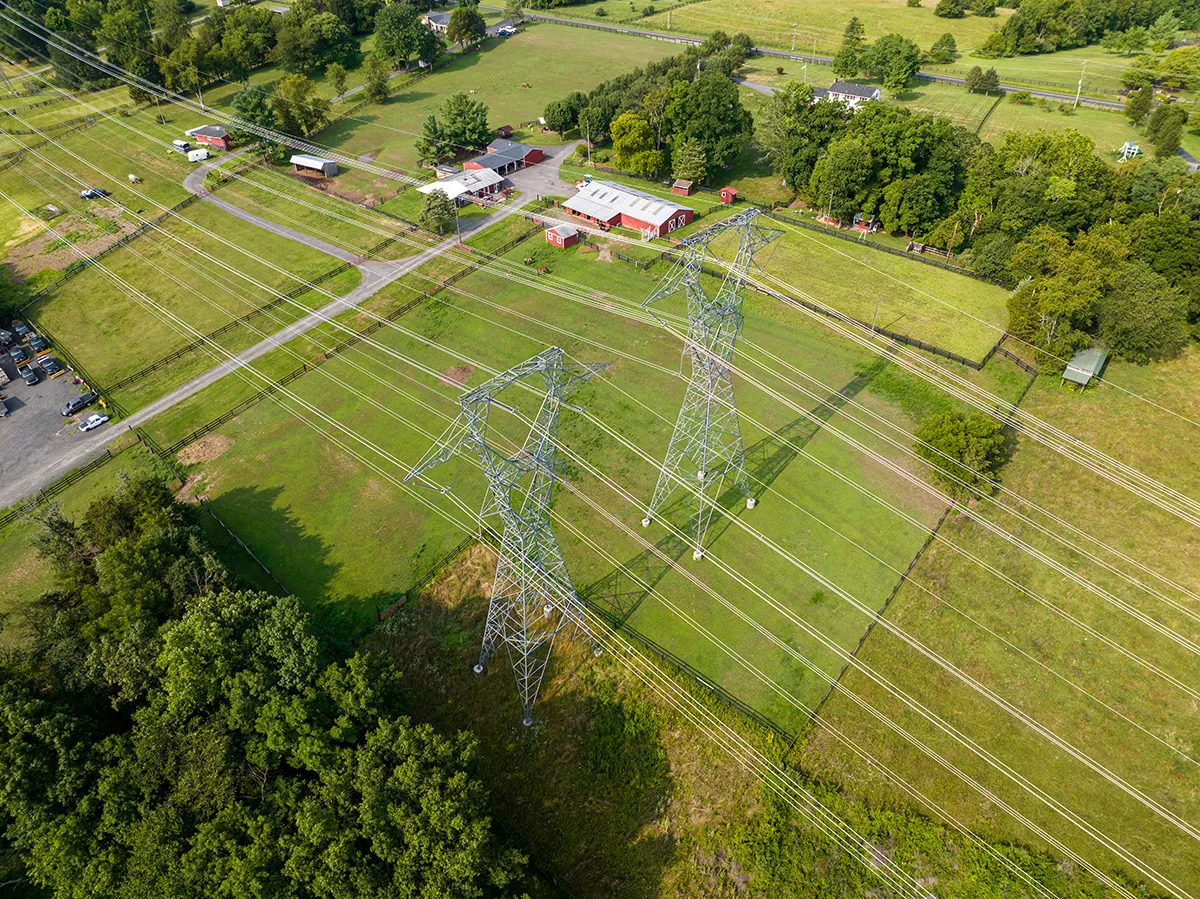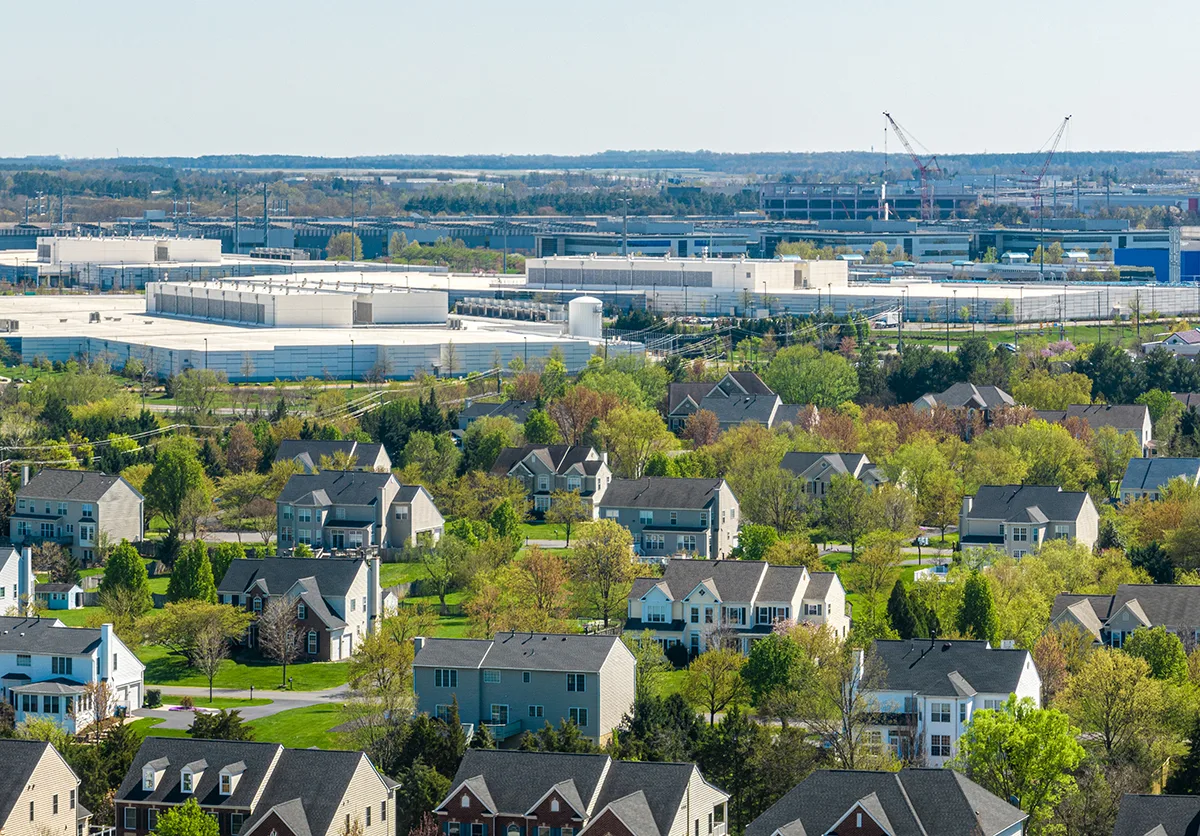View PEC’s webmap showing recently proposed transmission paths →
As we strive to advance Virginia’s clean energy future, a key focus area from our strategic plan, we must address the booming data center growth in our state that is requiring unprecedented expansions of our energy grid and hindering our ability to get off of fossil fuels.
Recently, Business Insider ran a story titled, “Data centers sprouting up as a result of the AI boom, minting fortunes, sucking up energy, and changing rural America.” This story explained that the now ubiquitous presence of data centers in places like Northern Virginia has a flip side: “The facilities consume quantities of power so vast that they have begun to tax entire energy grids and could exacerbate the climate crisis.”

Virginia is seeing the first results of this on our regional energy grid in the form of proposals for a new 1,000-megawatt (MW) natural gas facility in Chesterfield County and several new transmission lines that will traverse through Virginia, Maryland, Pennsylvania, and West Virginia communities with the primary purpose of delivering more power to Northern Virginia data center campuses. This is only the beginning, and progress on a clean energy future will be pushed further back if localities continue to approve more and more data center space without any regulatory oversight from the state.
Utilities are legally obligated to serve data centers, no matter how much energy they need or where they want it delivered. As a result, a tangled web of transmission lines descends upon our lands: local transmission line projects that directly serve new data center developments, regional transmission line projects to move large amounts of electricity from generation sources to regions where it is demanded, and brand new energy generation sources to provide what our existing energy system can’t. All of this infrastructure is largely paid for by Virginia ratepayers like you and me.
It is true that modern society worldwide is increasingly reliant on everything data centers make possible. It is also true that there needs to be a full accounting of the environmental, public health, and fiscal costs of data centers in the Commonwealth. Virginians, and Virginia, should not bear the brunt of hosting the majority of the world’s internet usage without greater transparency, better planning and meaningful mitigation.
Another question we often hear is: won’t we need new transmission to transition the grid to renewable energy sources? The answer is: yes. However, the transmission line projects in front of us aren’t that. They look a lot more like extension cords connecting power-hungry data centers to existing energy sources, locking us into an old model reliant on fossil fuels, when we need to be moving into the future.
The Chesterfield peaking plant, proposed by Dominion Energy to help meet expected increased energy demand linked to data center growth, would be the largest natural gas facility in the state. It would reduce air quality in the area, disproportionately impacting disadvantaged communities nearby. Rather than aiding our transition away from these heavily polluting energy sources, this plant would perpetuate their use for decades to come, bringing water and air pollution with it. Serving the data center industry’s exploding energy needs should be secondary to our transition to clean renewable energy and our state’s conservation goals.

More locally, PJM Interconnection, the regional grid operator in the mid-Atlantic, is moving forward with a number of transmission line projects to address the initial 7,500 MW of increased energy demand from data centers in Northern Virginia. PJM is charged with operating a competitive wholesale electricity market and managing the high-voltage electricity grid to ensure reliability.
From among 72 proposals by 10 utility entities, PJM has chosen to focus, for now, on two new pathways through northern Loudoun County and Maryland, as well as numerous upgrades and expansions, including projects in Albemarle, Fauquier, Prince William and Loudoun counties.
The total cost of these inter-regional transmission lines is $4.9 billion, which will be integrated into utility bills for all Virginia ratepayers. Meanwhile, Dominion Energy is also having discussions about other transmission lines to directly serve new data centers being built in Culpeper, Prince William, Fairfax, and Loudoun counties, which ratepayers will pay for as well. PJM’s set of recommended lines will be sent to the Board of Managers for final approval in mid-December.
Transmission Line Expansions Through Public and Private Conserved Lands
The new and expanded transmission line rights of way planned by PJM will cut through a number of conserved lands, including the newly formed Sweet Run State Park in northern Loudoun, Harpers Ferry National Historic Park, the Appalachian Trail, Waterford Historic District (a National Historic Landmark), Manassas National Battlefield Park, and numerous local parks, riparian buffers and privately held conservation easements.
The visual impact of these massive 500-kV lines should be obvious, but they also carry environmental impacts on waterways, forest resources and farms. The rights of way under these lines are cleared of trees, invite a proliferation of invasive species, and require repeated herbicide applications to keep them clear. The ground is disturbed as new poles are installed, and no barns or other permanent structures can ever be built under them.
With the state’s support and generous contributions of our members and landowners, conservation groups like PEC have worked hard to conserve places rich in natural and cultural resources. We have provided public access to treasured places and protected watersheds and the local agricultural food system through private land conservation. Encouraging unbridled data center development that requires sprawling transmission line expansions in these conserved places puts state policies at odds. In turn, the presence of transmission lines in areas designated as agricultural or forestland protection can negatively impact agricultural use, tourism, scenic appeal, and recreational value, increasing pressure for land conversion to sprawling industrial uses instead.
Coming Together Calling for Change
PEC has led the formation of the Virginia Data Center Reform Coalition, made up of more than 20 environmental, conservation, historic preservation, and climate advocacy groups, along with representatives of communities and neighborhoods across the state. This coalition is urging Virginia to study the cumulative effects of data center development on the state’s electrical grid, water resources, air quality, and land conservation efforts, and to institute several common-sense regulatory and rate-making reforms for this industry.
We are also calling on the Virginia General Assembly to require more transparency around energy and water usage, additional review of cumulative impacts at the state level, and adjustment of the rate structure to shift the cost of additional infrastructure resulting from global data usage away from Virginia ratepayers and onto the industry itself.
The enormous energy grid expansion tied to this growth is unprecedented. It amounts to a direct subsidy to the data center industry and Dominion Energy that will dramatically increase electric bills for homes and businesses, while simultaneously requiring residents to forfeit land and resources. As local approvals continue to pile up, the infrastructure debt and cumulative impacts on our environment and communities increase. Economic development that results in environmental degradation and leaves Virginians paying the bill is not progress. The state needs to pause approvals, study these issues, and get a handle on this industry before it is too late.
For more information and to get involved visit pecva.org/datacenters.
This article appeared in the 2023 winter edition of The Piedmont Environmental Council’s member newsletter, The Piedmont View. If you’d like to become a PEC member or renew your membership, please visit pecva.org/join.
